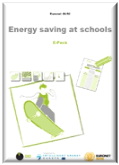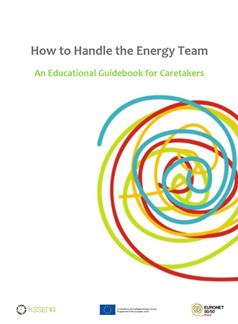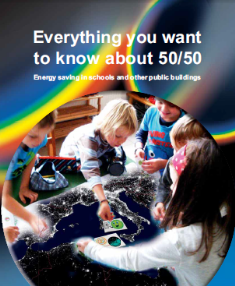 Ohjekirja ”Energiansäästö kouluissa”
Ohjekirja ”Energiansäästö kouluissa”
Ohjekirja näyttää vaihe vaiheelta miten 50/50 -menetelmä voidaan ottaa käyttöön kouluissa. Se sisältää monia hyödyllisiä ohjeita opettajille siitä, miten työskennellä energiatyöryhmässä. Se sisältää myös esimerkkejä taulukoista ja kokeista, joita voidaan käyttää oppilaiden energia- ja ympäristö kysymyksiin liittyvän tiedon kartuttamiseen. Voit ladata opettajan oppaat 50/50 Kirjastosta.
 Ohjekirja “50/50 vaihe vaiheelta. Energiansäästö kouluissa”
Ohjekirja “50/50 vaihe vaiheelta. Energiansäästö kouluissa”
Ohjekirjassa esitellään tiivistetysti ja mielenkiintoa herättävällä tavalla ensimmäisen EURONET 50/50 -projektin tulokset. Se sisältää myös monia hyödyllisiä vinkkejä 50/50 -konseptin käyttöönottoon ja valvomiseen kouluissa. Ohjekirjassa kerrotaan, miten 50/50 -projekti aloitetaan, miten sitä johdetaan, miten lasketaan energiansäästöt, ja mitä hyviä käytänteitä on jo käytössä 50/50 -verkostossa mukana olevissa kouluissa. Voit ladata ohjekirjan täältä.
 Guidebook “How to handle the energy team”
Guidebook “How to handle the energy team”
Guidebook is addressed to school caretakers (although also the teachers involved in the 50/50 project will find here many useful tips!) and will help them to prepare for the work with the energy team, including co-organisation of the energy review of the school building. Caretakers play very important role in the 50/50 project as they know best the school building and its energy system. Therefore, they can help the pupils analyse energy situation of their school and implement energy-saving measures. The publication contains many useful guidelines how to organise the work with the children, what information to transfer to them, as well as will help to prepare for the possible questions raised by the pupils. To download the guidebook, click here.
 Opas “Energiansäästö julkisissa rakennuksissa”
Opas “Energiansäästö julkisissa rakennuksissa”
This publications complements the guidebook „Energy saving at school” which was issued in the previous edition of the project. It focuses on implementation of the 50/50 methodology in non-educational public buildings. It informs what criteria must be met by these type of buildings, if they wish to engage in the 50/50 project, what is the role of local/regional self-government and the energy team, as well as explains step by step how to implement the 50/50 methodology in order to achieve energy and financial savings. Lataa opas täältä.
 Guidebook "Everything you want to know about 50/50"
Guidebook "Everything you want to know about 50/50"
The guidebook summarises all our experience gained within the 3 years of EURONET 50/50 MAX implementation that may be useful for other schools, buildings and municipalities wishing to launch the 50/50 project. It includes overall description of the 50/50 concept and following steps of the 50/50 methodology with some useful, practical tips and guidelines. It also presents many fascinating best practice examples from the 13 partner’s countries, actions developed by the 50/50 schools and public buildings, summary of the project results and much more. Lataa ohjekirja täältä.
 Opas "50/50 -projektin hyödyt julkisissa rakennuksissa"
Opas "50/50 -projektin hyödyt julkisissa rakennuksissa"
The guidebook summarises main aspects of implementation of the 50/50 concept in different types of public buildings. It highlights benefits of such approach, including contribution to the achievement of local climate & energy targets and demonstrating local authorities' commitment towards sustainable energy development. It also gives some useful tips about engaging building managers and building users in energy-saving actions. And by doing that significant energy savings can be achieved without large investments. Voit ladata oppaan täältä.
















 Vastuu tämän sivuston sisällöstä on yksinomaan kirjoittajilla. Se ei välttämättä edusta Euroopan Unionin mielipidettä. EACI (Kilpailukyvyn ja innovoinnin toimeenpanovirasto) tai Euroopan komissio eivät ole vastuussa mistään tämän sivuston tietojen käytöstä.
Vastuu tämän sivuston sisällöstä on yksinomaan kirjoittajilla. Se ei välttämättä edusta Euroopan Unionin mielipidettä. EACI (Kilpailukyvyn ja innovoinnin toimeenpanovirasto) tai Euroopan komissio eivät ole vastuussa mistään tämän sivuston tietojen käytöstä.